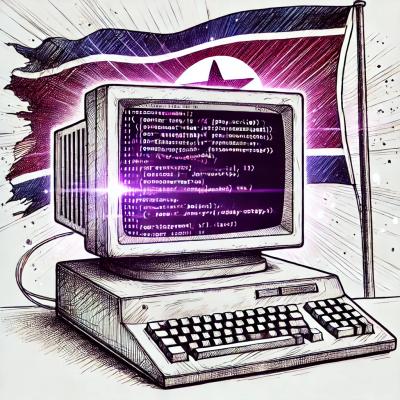
Security News
TypeScript is Porting Its Compiler to Go for 10x Faster Builds
TypeScript is porting its compiler to Go, delivering 10x faster builds, lower memory usage, and improved editor performance for a smoother developer experience.
Efficient server proxying and mocking in Node.js. :muscle:

The README is supposed to only give you a basic idea what kras is. To truly find out about all the possibilities and details the getting started document will give you the right pointers and pieces of information.
kras is meant to be a Swiss army knife for server mocking. It is meant for the development of large web applications that consist of a (decoupled) frontend and backend part (e.g., frontend MVC heavy, like a SPA, backend a (micro) service landscape, potentially behind a gateway).
Some cases where the mocking makes sense:
There are countless more scenarios where mocking (or intelligent proxying) makes sense. This can go beyond standard REST, e.g., what if the backend has a websocket endpoint for sending events? kras can help us in such scenarios as well - its websocket proxying also allows us to be in the middle and actively send (i.e., broadcast) data to connected clients. This makes it possible to mock these events in question as well.
One sentence to describe the usage of kras is:
With kras you can truly decouple the development of frontend and backend. It can be an API server, it can be a static or dynamic proxy, it can be everything you need to bend the backend at your will.
Most importantly, kras supports mocking multiple servers (i.e., hostnames) by path-prefixing them. You'll just need to open a single port for all needs.
There are two basic ways to use kras. Either globally installed, i.e.,
npm i kras -g
or locally as a development dependency for your project:
npm i kras -D
While the former may be good in general to play around, the latter should be preferred to actually share / configure kras for the particular project.
Running kras can then be done, e.g., via specifying the kras command (global usage) or referring to kras via the npm scripts in the package.json. kras can also be used programmatically, e.g., in a webpack configuration. The library exports several classes and functions that help you establish a mock server for your project in no time.
The following animation shows the first-time experience, where the default configuration is used:

kras uses configuration files and command line options to be properly configured. The configuration files are named .krasrc and are looked up in the following order:
Configuration options are in general flat merged from left to right. Special properties, such as middlewares, injectors, map, or sources are merged (one-level deep) and not overwritten.
npx kras --help
If specified the command line options have higher precedence. The following options exist.
-c, --config Sets the configuration file to use, by default .krasrc
[string]
-p, --port Sets the port of the server, by default 9000 [number]
-n, --name Sets the name of the server, by default kras v0.15.2 [string]
-d, --dir Sets the base directory of the server, by default
/home/rapplf/Code/Piral/kras/mocks [string]
--host Sets the host binding of the server, by default 0.0.0.0
[string]
--cert Sets the certificate of the server, by default
/home/rapplf/Code/Piral/kras/cert/server.crt [string]
--key Sets the key of the server, by default
/home/rapplf/Code/Piral/kras/cert/server.key [string]
-l, --log-level Sets the log level of the application, by default error
[choices: "info", "debug", "error"]
--skip-api If set avoids creating the management API endpoint [boolean]
--map Sets the different mappings, e.g.,
"--map./=https://httpbin.org"; can be used multiple times
[default: {}]
--version Show version number [boolean]
-h, --help Shows the argument descriptions [boolean]
The .krasrc is a simple JSON format. An example is the following configuration:
{
"name": "kras",
"port": 9000,
"host": "0.0.0.0",
"directory": ".",
"uploadLimit": 10,
"logLevel": "error",
"ssl": {
"cert": "cert/server.crt",
"key": "cert/server.key"
},
"api": "/manage",
"map": {
"/": "https://httpbin.org",
"/api": "https://jsonplaceholder.typicode.com",
"/events": "ws://demos.kaazing.com/echo"
},
"injectors": {
"script": {
"active": true,
"directory": "db/"
},
"har": {
"active": true,
"directory": "db/",
"delay": false
},
"json": {
"active": true,
"directory": "db/"
},
"proxy": {
"active": true
},
"store": {
"active": false,
"directory": "db/"
}
}
}
Pretty much everything can also be configured from the CLI, e.g.:
npx kras --map./=https://httpbin.org --map./api=https://jsonplaceholder.typicode.com --map./events=ws://demos.kaazing.com/echo
For more information regarding the CLI options use --help as written above.
Directory paths are always resolved to an absolute with respect to the location of the containing configuration file. The injector sections are actually dynamic settings that are transported as-is to the respective injector. An injector is just a request handler, which may know how to get an answer to the current request.
The configuration of kras can also be (partially) changed during runtime using the management endpoint. By default this endpoint can be accessed at https://localhost:9000/manage. Please note that the HTTPS could be changed to HTTP (if the ssl option was disabled), the port could be changed, and the endpoint itself could be changed.
Disabling the management endpoint can be done by setting the api option false.
We are totally open for contribution and appreciate any feedback, bug reports, or feature requests. More detailed information on contributing incl. a code of conduct are soon to be presented.
Regarding the plans / strategy for kras we also published a roadmap document.
What does kras mean?
kras is the abbreviation for "kein reiner API server" (German), indicating that kras is actually not (only or exclusively) an API server, but just serving (or proxying) content from an arbitrary server (which could be an API server, of course). Literally, it means "not a pure API server" referring to the number of possibilities for serving any HTTP-based content plus websockets.
Is kras useful for unit and / or integration tests?
I think so, even though real end-to-end tests should be performed against the real backend. Nevertheless, using kras we can rely on fixed contracts for our backend. Additionally, it allows us to run these tests even when no Internet connection is available. For unit tests the big advantage is that the mocking part is not / has not to be configured within our own code base, but in an external one. This is a little bit more robust against refactoring.
Can the order of the injectors be changed?
Yes, totally. The order is given by the order in the JSON defining the different injectors, e.g., swapping two entries in the JSON will result in changing the order of the injectors respectively.
Why is the server HTTPS by default?
Normally, API servers in most projects are HTTPS only. Thus the configuration part in standard code may be reduced to a hostname, e.g.,
function buildApiServer(host) {
return `https://${host}/api`;
}
where host can be the actual host in one particular environment (e.g., production or stage), but could also be replaced by, e.g., localhost:9000/foo. Long story short, it seemed like a sound choice.
The default certificate is not trusted - what can I do about it?
Well, you could add the certificate to your trusted roots and therefore get rid of the message. However, if you (understandably) don't want to trust third-party generated certificates you can also generate your own certificate and use that one instead. Finally, you could either switch off HTTPS (disable SSL), or use a special browser instance with SSL checking disabled (for Chrome starting with the command line flag --ignore-certificate-errors does the trick; don't use this for browsing the public web).
How can I use kras with webpack?
There are several ways on how to use kras with webpack. The two most common ways are documented in detail here. In general, the idea is to run kras side by side to the webpack dev server. This can be archieved by modifying the used webpack.config.js or by concurrently running two processes. Of course, programmatically, it can be also achieved to run the webpack dev server and kras on the same port, however, the gain is potentially not worth the effort (at least for most users).
Isn't this the same as http-proxy-middleware?
http-proxy-middleware is a great package. Maybe if I would have known about it earlier kras (or any earlier form of it) would not exit. But kras is different. While http-proxy-middleware gives you a tool for being used in an Express application, kras gives you a full server including a finished client for simple modifications and interactions during runtime. Furthermore, kras can be used as a library, which creates the full server for you. Finally, kras tries to be easy to extend with its injector model, which is completely independent of Express or any other HTTP framework. The way I see it http-proxy-middleware would be the lib of choice for bringing proxy-ing capabilities to an Express application, while kras is the tool of choice for general mocking or proxy-ing of requests via a localhost service.
Can I write my own injector?
Yes. Injectors are powerful stuff and can be written in your own code base / project or in their own repository. They could be globally registered or published via NPM. More details can be found here.
I don't like the web client - what can I do?
The bundled client is only the default client. If you prefer you can interact with kras via curl or postman or any other possibility to run raw API requests. If this is too tedious you could also write a custom client. If the client is registered as an NPM package kras can also (via the configuration) serve that client from the management endpoint. Details are aggregated in the client documentation.
I need to protect the management API but how?
The management API can be protected with the auth option. More information can be read in the authentication documentation.
kras is released using the MIT license. For more information see the LICENSE file.
1.0.0
connected and disconnected events in scriptssetup and teardown lifecycleproxyWebSocket to exported utilitiesFAQs
Efficient server proxying and mocking in Node.js.
The npm package kras receives a total of 4,676 weekly downloads. As such, kras popularity was classified as popular.
We found that kras demonstrated a healthy version release cadence and project activity because the last version was released less than a year ago. It has 0 open source maintainers collaborating on the project.
Did you know?

Socket for GitHub automatically highlights issues in each pull request and monitors the health of all your open source dependencies. Discover the contents of your packages and block harmful activity before you install or update your dependencies.

Security News
TypeScript is porting its compiler to Go, delivering 10x faster builds, lower memory usage, and improved editor performance for a smoother developer experience.

Research
Security News
The Socket Research Team has discovered six new malicious npm packages linked to North Korea’s Lazarus Group, designed to steal credentials and deploy backdoors.

Security News
Socket CEO Feross Aboukhadijeh discusses the open web, open source security, and how Socket tackles software supply chain attacks on The Pair Program podcast.